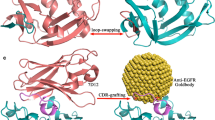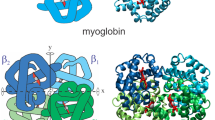Abstract
Hydrogen exchange experiments (Krishna et al. in J. Mol. Biol. 359:1410, 2006) reveal that folding–unfolding of cytochrome c occurs along a defined pathway in a sequential, stepwise manner. The simplified zipper-like model involving nonadditive coupling is proposed to describe the classical “on pathway” folding–unfolding behavior of cytochrome c. Using free energy factors extracted from HX experiments, the model can predict and explain cytochrome c behavior in spectroscopy studies looking at folding equilibria and kinetics. The implications of the proposed model are discussed for such problems as classical pathway vs. energy landscape conceptions, structure and function of a native fold, and interplay of secondary and tertiary interactions.
Similar content being viewed by others
References
Frauenfelder, H., Wolynes, P.G., Austin, R.H.: Biological physics. Rev. Mod. Phys. 71, 419–430 (1999)
Onuchic, J.N., Luthey-Schulten, Z., Wolynes, P.G.: Theory of protein folding: the energy landscape perspective. Annu. Rev. Phys. Chem. 48, 545–600 (1997)
Levinthal, C.: How to fold graciously. In: Mossbauer Spectroscopy in Biological Systems: Proceedings of the University of Illinois Bulletin, vol. 67, pp. 22–24 (1969)
Zwanzig, R., Szabo, A., Bagghi, B.: Levinthal’s paradox. Proc. Natl. Acad. Sci. USA 89, 20–22 (1992)
Konermann, L.: Exploring the relationship between funneled energy landscapes and two-state protein folding. Proteins 65, 153–163 (2006)
Levinthal, C.: Are there pathways for protein folding? J. Chim. Phys. 65, 44–45 (1968)
Kim, P.S., Baldwin, R.L.: Intermediates in folding reactions of small proteins. Annu. Rev. Biochem. 59, 631–660 (1990)
Englander, S.W.: Protein folding intermediates and pathways studied by hydrogen exchange. Annu. Rev. Biophys. Biomol. Struct. 29, 213–238 (2000)
Bai, Y.: Protein folding pathways studied by pulsed- and native-state hydrogen exchange. Chem. Rev. 106, 1757–1768 (2006)
Bryngelson, J.D., Onuchic, J.N., Socci, N.D., Wolynes, P.G.: Funnels, pathways and the energy landscape protein folding: a synthesis. Proteins 21, 167–195 (1995)
Chan, H.S., Dill, K.A.: Protein folding in the landscape perspective: Chevron plots and non-Arrhenius kinetics. Proteins 30, 2–33 (1998)
Onuchic, J.N., Wolynes, P.G.: Theory of protein folding. Curr. Opin. Struct. Biol. 14, 70–75 (2004)
Bai, Y., Sosnick, T.R., Mayne, L., Englander, S.W.: Protein folding intermediates: native-state hydrogen exchange. Science 269, 192–197 (1995)
Krishna, M.M.G., Maity, H., Rumbley, J.N., Lin, Y., Englander, S.W.: Order steps in the cytochrome c folding pathway: evidence for a sequential stabilization mechanism. J. Mol. Biol. 359, 1410–1419 (2006)
Cecconi, C., Shank, E.A., Bustamante, C., Marqusee, S.: Direct observation of the three state folding of a single protein molecule. Science 309, 2057–2060 (2000)
Feng, H., Zhou, Z., Bai, Y.: A protein folding pathway with multiple folding intermediates at atomistic resolution. Proc. Natl. Acad. Sci. USA 102, 5026–5031 (2005)
Baldini, G., Cannone, F., Chirico, G., Collini, M., Campanini, B., Bettati, S., Mozzarelli, A.: Evidence of discrete substates and unfolding pathways in green fluorescent protein. Biophys. J. 92, 1724–1731 (2007)
Privalov, P.L., Khechinashvilli, N.N.: A thermodynamic approach to the problem of stabilization of globular protein structure: a calorimetric study. J. Mol. Biol. 86, 665–684 (1974)
McLendon, G., Smith, M.: Equilibrium and kinetic studies of unfolding of homologous cytochromes c. J. Biol. Chem. 253, 4004–4008 (1978)
Tsong, T.Y.: Detection of three kinetic phases in the thermal unfolding of ferricytochrome c. Biochemistry 12, 2209–2214 (1973)
Myer, Y.P.: Ferricytochrome c refolding and the methionine 80–sulfur–iron linkage. J. Biol. Chem. 259, 6127–6133 (1984)
Elöve, G.A., Chaffotte, A.F., Roder, H., Goldberg, M.E.: Early steps in cytochrome c folding probed by time-resolved circular dichroism and fluorescence spectroscopy. Biochemistry 31, 6876–6883 (1992)
Knapp, J., Pace, C.N.: Guanidine hydrochloride and acid denaturation of horse, cow and Candida krusei cytochrome c. Biochemistry 13, 1289–1294 (1974)
Maine, L., Englander, S.W.: Two-state vs. multistate protein unfolding studied by optical melting and hydrogen exchange. Protein Sci. 9, 1873–1877 (2000)
Latypov, R.F., Cheng, H., Roder, N.A., Zhang, J., Roder, H.: Structural characterization of an equilibrium unfolding intermediate in cytochrome c. J. Mol. Biol. 357, 1009–1025 (2006)
Roder, H., Elöve, G.A., Englander, S.W.: Structural characterization of folding intermediates in cytochrome c by H-exchange labelling and proton NMR. Nature 335, 700–704 (1988)
Xu, Y., Mayne, L., Englander, S.W.: Evidence for an unfolding and refolding pathway in cytochrome c. Nat. Struct. Biol. 5, 774–778 (1998)
Hoang, L., Bedard, S., Krishna, M.M.G., Lin, Y., Englander, S.W.: Cytochrome c folding pathway: kinetic native-state hydrogen exchange. Proc. Natl. Acad. Sci. USA 99, 12173–12178 (2002)
Krishna, M.M.G., Lin, Y., Mayne, L., Englander, S.W.: Intimate view of a kinetic protein folding intermediate: residue-resolved structure, interactions, stability and unfolding rates, homogenity. J. Mol. Biol. 334, 501–513 (2003)
Maity, H., Maity, M., Englander, S.W.: How cytochrome c folds, and why: submolecular foldon units and their stepwise sequential stabilization. J. Mol. Biol. 343, 223–233 (2004)
Maity, H., Maity, M., Krishna, M.M.G., Mayne, L., Englander, S.W.: Protein folding: the stepwise assembly of foldon units. Proc. Natl. Acad. Sci. USA 102, 4741–4746 (2005)
Lifson, S., Roig, A.: On the theory of helix–coil transitions in polypeptides. J. Chem. Phys. 34, 1963–1974 (1961)
Bryngelson, J.D., Wolynes, P.G.: Spin glasses and the statistical mechanics of protein folding. Proc. Natl. Acad. Sci. USA 84, 7524–7528 (1987)
Thompson, P.A., Muñoz, V., Jas, G.S., Henry, E.R., Eaton, W.A., Hofrichter, J.: The helix–coil kinetics of a heteropeptide. J. Phys. Chem. B 104, 378–389 (2000)
Liang, K.K., Hayashi, M., Shiu, Y.J., Mo, Y., Shao, J., Yan, Y., Lin, S.H.: Thermodynamics and kinetics of protein folding: a mean field theory. Phys. Chem. Chem. Phys. 5, 5300–5308 (2003)
Morozov, A.N., Lin, S.H.: Modeling of folding unfolding mechanism in alanine based alpha helical polypeptides. J. Phys .Chem. B 110, 20555–20561 (2006)
Hairyan, S.A., Mamasakhlisov, E.S., Morozov, V.F.: The helix–coil transition in polypeptides: a microscopic approach. II. Biopolymers 35, 75–84 (1995)
Hansen, A., Jensen, M.H., Sneppen, K., Zocchi, G.: A hierarchical scheme for cooperativity and folding in proteins. Physica A 250, 355–361 (1998)
Fichthorn, K., Weinberg, W.H.: Theoretical foundations of dynamical Monte Carlo simulations. J. Chem. Phys. 95, 1090–1096 (1991)
Weinkam, P., Zong, C., Wolynes, P.G.: A funneled energy landscape for cytochrome c directly predicts the sequential folding route inferred from hydrogen exchange experiments. Proc. Natl. Acad. Sci. USA 102, 12401–12406 (2005)
Bruscolini, P., Pelizzola, A.: Exact solution of the Muñoz–Eaton model for protein folding. Phys. Rev. Lett. 88, 258101 (2002)
Boeglin, A., Zhang, X.-G., Lin, S.H.: On the microscopic approach of the mean field kinetic Ising model. Physica A 137, 439–453 (1986)
Makhatadze, G.I., Privalov, P.L.: Protein interactions with urea and guanidinium chloride: a calorimetric study. J. Mol. Biol. 226, 491–505 (1992)
Smith, P.E.: The alanine dipeptide free energy surface in solution. J. Chem. Phys. 111, 5568–5579 (1999)
Baldwin, R.L., Rose, G.D.: Is protein folding hierarchic? I. Local structure and peptide folding. Trends. Biochem. 24, 26–33 (1999)
Dragomir, I., Hagarman, A., Wallace, C., Schweitzer-Stenner, R.: Optical band splitting and electronic perturbations of the heme chromophore in cytochrome c at room temperature probed by visible electronic circular dichroism spectroscopy. Biophys. J. 92, 989–998 (2007)
Milne, J.S., Xu, Y., Mayne, L.C., Englander, S.W.: Experimental study of the protein folding landscape: unfolding reactions in cytochrome c. J. Mol. Biol. 290, 811–822 (1999)
Madison, V., Schelmann, J.: Optical activity of polypeptides and proteins. Biopolymers 11, 1041–1076 (1972)
Bushnell, G.W., Louie, G.V., Brayer, G.D.: High-resolution three-dimensional structure of horse heart cytochrome c. J. Mol. Biol. 214, 585–595 (1990)
Scholtz, J., Marqusee, S., Baldwin, R.L., York, E.J., Stewart, J.M., Santoro, M., Bolen, D.W.: Calorimetric determination of the enthalpy change for the alpha-helix to coil transition of an alanine peptide in water. Proc. Natl. Acad. Sci. USA 88, 2854–2858 (1991)
Shastry, M.C., Roder, H.: Evidence for barrier-limited protein folding kinetics on the microsecond time scale. Nat. Struct. Biol. 5, 385–392 (1998)
Krishna, M.M.G., Lin, Y., Rumbley, J.N., Englander, S.W.: Cooperative omega loops in cytochrome c: role in folding and function. J. Mol. Biol. 331, 29–36 (2003)
Fetrow, J.S.: Protein motifs 6. Omega-loops—nonregular secondary structures significant in protein function and stability. FASEB J. 9, 708–717 (1995)
Shiu, Y.J., Jeng, U.S., Su, C., Huang, Y.S., Hayashi, M., Liang, K.K., Yeh, Y.L., Lin, S.H.: A modified Ising model for the thermodynamic properties of local and global protein folding–unfolding observed by circular dichroism and small angle X-ray scattering. J. Appl. Crystallogr. (Suppl) 40, 195–199 (2007)
Bryngelson, J.D., Wolynes, P.G.: Intermediates and barrier crossing in a random energy model (with applications to protein folding). J. Phys. Chem. 93, 6902–6915 (1989)
Metzler, R., Klafter, J., Jortner, J.: Hierarchies and logarithmic oscillations in the temporal relaxation patterns of proteins and other complex systems. Proc. Natl. Acad. Sci. USA 96, 11085–11089 (1999)
Colon, W., Elöve, G.A., Wakem, L.P., Shermann, F., Roder, H.: Side chain packing plays a critical role in the kinetics of cytochrome c folding. Biochemistry 35, 5538–5549 (1996)
Sosnick, T.R., Mayne, L., Hiller, R., Englander, S.W.: The barriers in protein folding. Nat. Struct. Biol. 1, 149–156 (1994)
Wood, L.C., White, T.B., Ramdas, L., Nall, B.T.: Replacement of a conserved proline eliminates the absorbance-detected slow folding phase of iso-2-cytochrome c. Biochemistry 27, 8562–8568 (1988)
Dill, K.A., Fiebig, K.M., Chan, H.S.: Cooperativity in protein-folding kinetics. Proc. Natl. Acad. Sci. USA 90, 1942–1946 (1993)
Voelz, V.A., Dill, K.A.: Exploring zipping and assembly as a protein folding principle. Proteins 66, 877–888 (2007)
Lednev, I.K., Karnoup, A.S., Sparrow, M.C., Asher, S.A.: Transient UV Raman spectroscopy finds no crossing barrier between the peptide R-helix and fully random coil conformation. J. Am. Chem. Soc. 123, 2388–2392 (2001)
Muñoz, V., Ghirlando, R., Blanco, F.J., Jas, G.S., Hofritcher, J., Eaton, W.A.: Folding and aggregation kinetics of a β-hairpin. Biochemistry 45, 7023–7035 (2006)
Makarov, D.E., Plaxco, K.: The topomer search model: a simple, quantitative theory of two-state protein folding kinetics. Protein Sci. 12, 17–26 (2003)
Young, W.S., Brooks III, C.L.: A Microscopic view of helix propagation; N and C terminal growth in alanine helices. J. Mol. Biol. 259, 560–572 (1996)
Author information
Authors and Affiliations
Corresponding author
Rights and permissions
About this article
Cite this article
Morozov, A.N., Shiu, Y.J., Liang, C.T. et al. Nonadditive Interactions in Protein Folding: The Zipper Model of Cytochrome c . J Biol Phys 33, 255–270 (2007). https://doi.org/10.1007/s10867-008-9062-7
Received:
Accepted:
Published:
Issue Date:
DOI: https://doi.org/10.1007/s10867-008-9062-7




